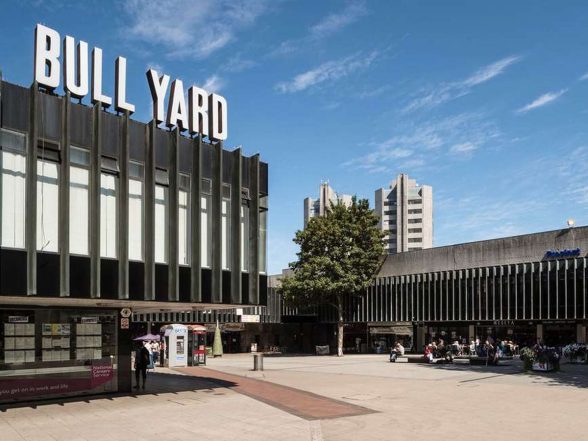This website uses cookies
This website uses cookies to enable it to function properly and to analyse how the website is used. Please click 'Close' to accept and continue using the website.


Bull Yard, Coventry

Image: Coventry Telegraph
A massive planning application by the London based Shearer Property Group and Chapman Taylor architects, in a joint venture with Coventry City Council, would see half of the town centre demolished, obliterating much of what is special about Coventry’s post war heritage, replacing it with 50 new retail units, a pavilion containing independent and start-up retailers and restaurants, a cinema and other leisure facilities, private and rented residential accommodation and a hotel.
The 15-acre City Centre South redevelopment scheme includes the loss of the Bull Yard shopping precinct, alterations to the Grade II listed Retail Market and the removal and relocation of the Grade II listed Three Tuns William Mitchell concrete mural which forms the front elevation of the former Three Tuns Pub within Bull Yard. The fate of a number of other important post-war artworks including the additional Mitchell fibreglass and concrete panels works in Hertford Street, People of Coventry sculptures and Sir Guy and the Dun Cow, is also in doubt.
The City Centre South site was planned, designed and built by Coventry’s city architect and planning officer, initially Arthur Ling (from 1955) and later Terence Gregory (from 1963). The Coventry Retail Market was built in 1957 to designs by Douglas Beaton, Ralph Iredale and Ian Crawford of Coventry City Architect’s Department. It is a Festival of Britain style building arranged on a circular plan and built from concrete with brick infill. The building is ringed with shops and its flat roof is laid out as a carpark, serving, as the list entry explains, as “the central focus for a complex scheme of linked roof car parks in Coventry.”
It is not just the post war architecture of City Centre South which is under threat. In the recent past, Coventry City Council has permitted development which has had a detrimental impact on its listed buildings. The Coventry Rail Station Masterplan was approved, enabling the construction of an overbearing new station entrance and bus terminal opposite the Grade II listed train station; the Civic Centre buildings were demolished and Coventry Civic Centre 2, despite being Grade II listed in 2017, is being drastically altered; and the Grade II Coventry Central Baths and Leisure Centre (known as “The Elephant”), have been under threat for years. Dr. Otto Saumarez Smith, a C20 trustee and architectural and urban historian at the University of Warwick, recently wrote in Apollo Magazine: “With a more sympathetic approach, Coventry might aspire in a few decades to become a World Heritage Site, emulating places such as Bath or Ironbridge – because it too is a supremely eloquent exemplar of a particular moment in urban history.” That is if it survives the wrecking ball.

Become a C20 member today and help save our modern design heritage.